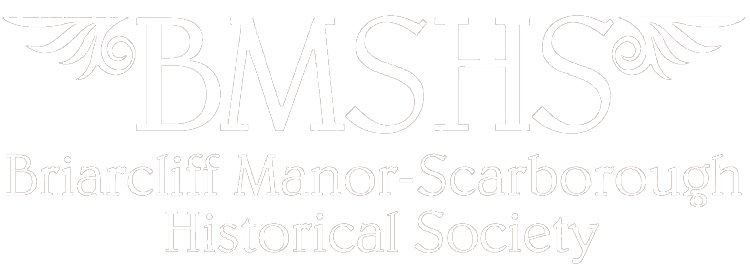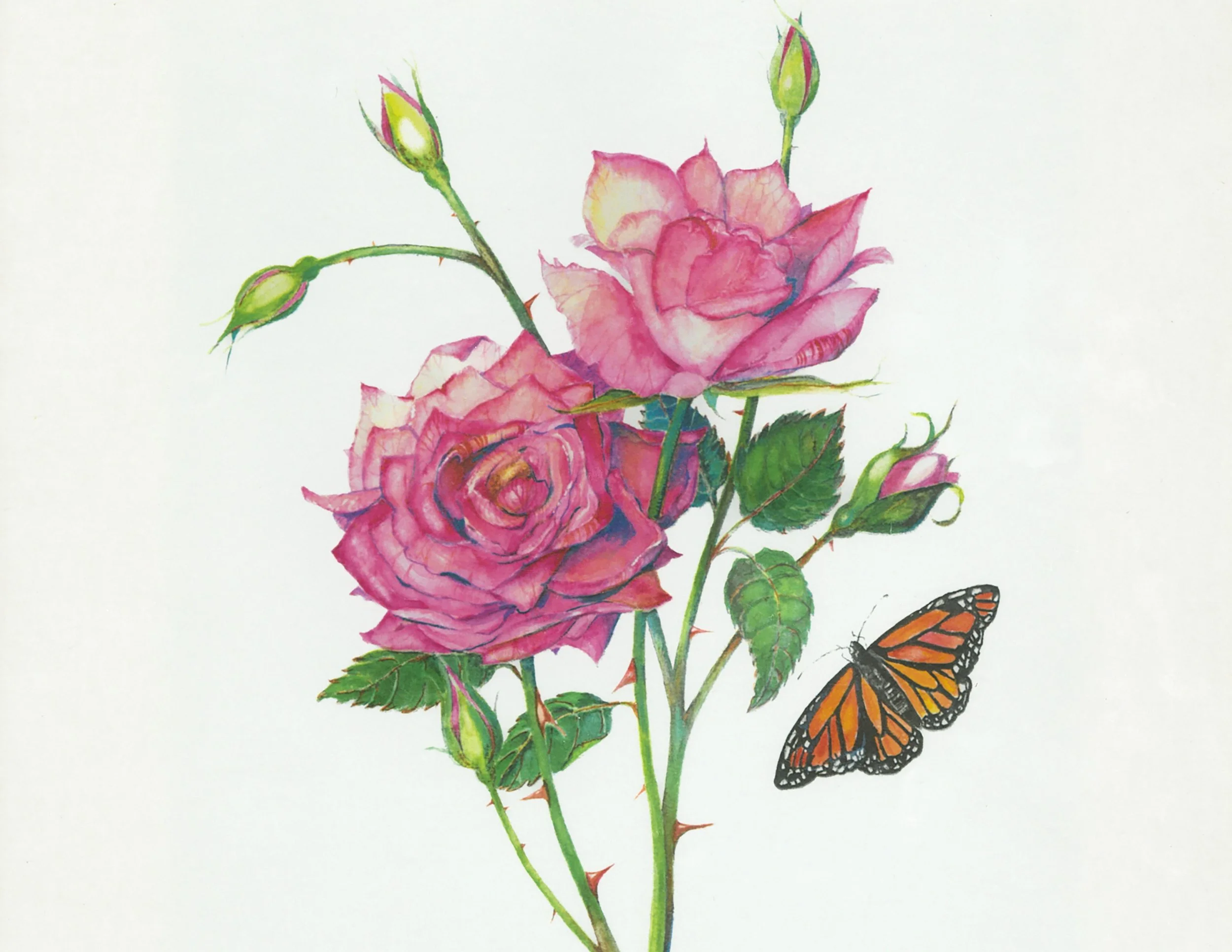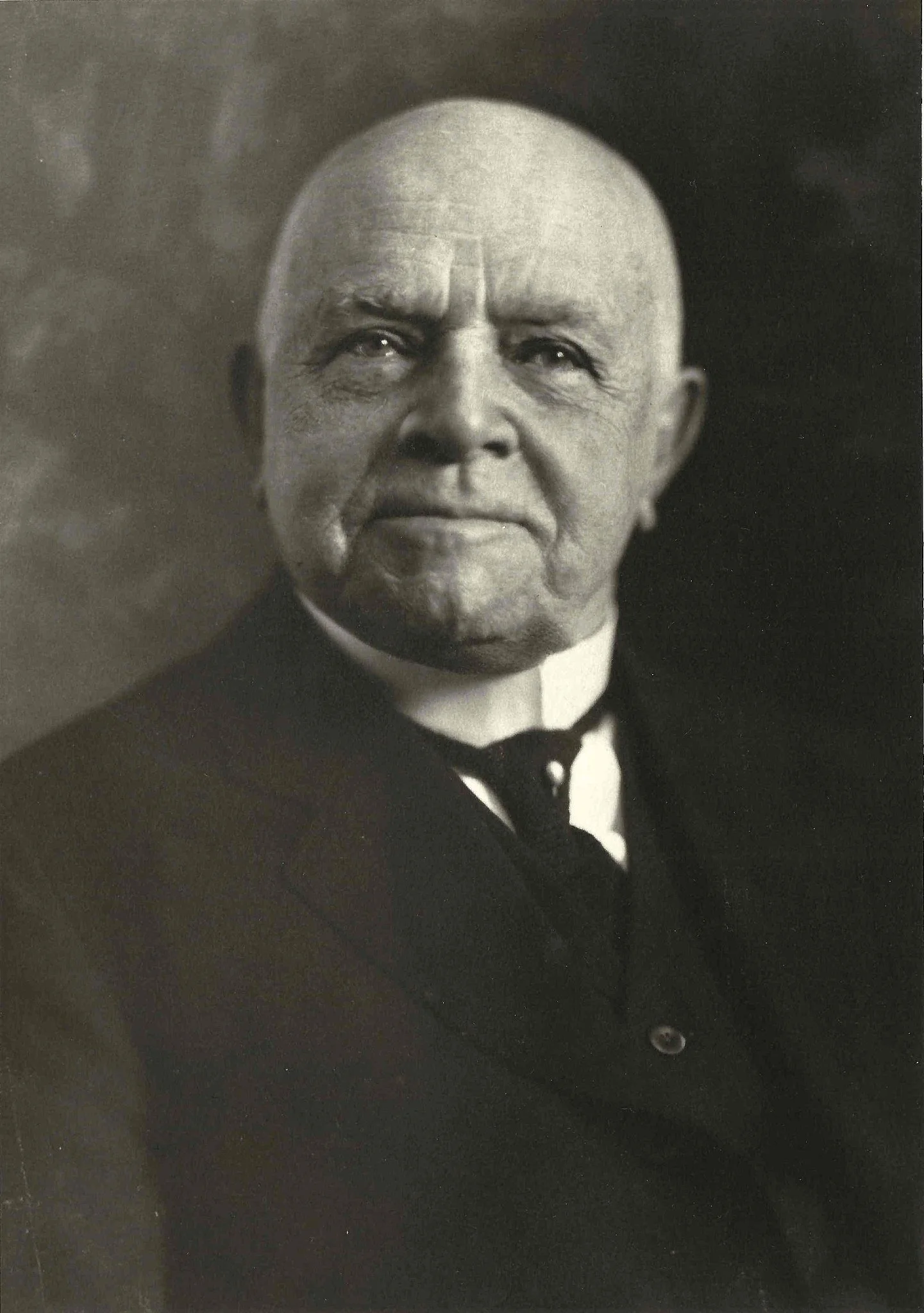Part of our is mission is to increase awareness of the history of the Village of Briarcliff Manor. To this end this section provides a series of articles featuring some of the historic and notable buildings, events, and people of our village.
Over time we will add articles, and/or update existing articles. When we do we will send out a notification by e-mail. We welcome comments and suggestions for the BMSHS History Notebook, which can be sent to mail@briarcliffhistory.org. If you have a question please send it to us and we will do our best to find the answer.
The Story of the Briarcliff Rose. Notebook 2025-10
The Briarcliff Rose became a symbol of the village’s elegance and horticultural excellence. It was known for its beauty and quality and was often featured in high-society events and luxury venues. The rose helped put Briarcliff Manor on the map as a place of sophistication and charm. It was supplied to top-tier hotels (including the Briarcliff Lodge itself) and restaurants in New York City, and even to transatlantic ocean liners. It was considered among the best pink roses for the florist trade.
The Plasmon Saga. Notebook 2025-9.
At the turn of the twentieth century, the Industrial Revolution changed the nature of food production worldwide. As the advent of efficient farm tools and larger factories enabled more production of manufactured food, prices dropped, and many Americans found that they could access food more easily. But as the amount of food in households increased, society also found itself facing a new problem: food waste. Thus, the late 1800s and early 1900s also marked a period of scientific inquiry into strategies to diminish food waste. And by the end of the 19th century, while researching ways to reduce food waste, a Swiss (some sources say German) chemist called Seibold (some sources say Siebold) developed what he believed to be the world’s newfound superfood. Using skimmed milk waste and containing incredible nutritional value, Seibold’s discovery would eventually become known as “Plasmon.”
The Briarcliff Lodge. Notebook 2025-8.
For 101 years, a most magnificent building stood in the heart of Westchester County. Embracing the finest elements of domestic architecture of its time, Briarcliff Lodge was a resort hotel that catered to future U.S. presidents, New York State governors, foreign dignitaries, business leaders, movie stars, and professional athletes.
The Lodge was abandoned in December 1994, and plans for its adaptive reuse were strongly contested. Yet, the old hotel retained much of its original architectural and structural integrity into the 21st century. Finally, in 2003, a development plan for the property was approved, which included the demolition of Briarcliff Lodge. On September 20, 2023, the original 1902 wood-frame structure burned to the ground.
Walter W. Law - From Rugs to Riches. Notebook 2025-7.
Walter William Law (November 13, 1837 – January 17, 1924) was a businessman and the founder of the 8,000-person village of Briarcliff Manor, New York. He was a vice president of furniture and carpet retailer W. & J. Sloane, and later founded the Briarcliff Lodge, the Briarcliff Table Water Company, Briarcliff Farms, and the Briarcliff Greenhouses. He founded or assisted in establishing several schools, churches, and parks in the village, and rebuilt its train station in 1906. In the early 1900s, Walter Law was the largest individual landholder in Westchester County
All Saints Episcopal Church, Briarcliff Manor - Notebook 2025-6.
All Saints' Episcopal Church is a historic Episcopal church in Briarcliff Manor, New York. It was added to the National Register of Historic Places in 2002. John David Ogilby, whose summer estate and family home in Ireland were the namesakes of Briarcliff Manor, founded the church in 1848. The church was built on Ogilby's summer estate in Briarcliff Manor. Since the closing of St. Mary’s Episcopal Church, Briarcliff Manor in July 2015 All Saints has become the oldest church in Briarcliff Manor.
A Short Chronology of the Archville Fire Department and the Scarborough Fire District - Notebook 2025-5
The hamlet of Archville is so named for the Arched structure that was built to carry the Croton Aqueduct over the Albany Post Road at the bottom of Arch Hill. The structure was built between 1835 and 1842 as part of the system to carry water into New York City. The structure was finally torn down in 1924 to provide a safer roadway.
The history of the Archville Fire Company dates back to the year 1907 when Leonard S.Sherwood and several other residents in the Archville section, began to organize fire service in the area.
On May 4, 1929, the voters of Briarcliff Manor were asked to approve the creation of Archville Company becoming part of the Briarcliff Department. The Board approved an expenditure of $10,000 to complete the merger.
The Archville Department was now renamed the Scarborough Fire Company.
Mike Bassett, a long time member of the various Briarcliff Manor Fire Departments tells the story of what happened afterwards.
Admiral John Lorimer Worden and the Battle of Hampton Roads. Notebook 2025-4
If you’ve driven North on Route 9/Albany Post Road you might have noticed, just before the intersection with Scarborough Road, the blue historical marker below. Since traffic along Route 9 moves quite quickly you might not have been able to read the text on the marker. However, the sign marks the birthplace of a man who commanded arguably the most important warship in US history at one of the most important naval battles in US history.
Miramont Court/Brandywine, the Estate of Isaac Newton Spiegelberg. Notebook 2025-3
Isaac Newton Spiegelberg was born in 1859. His family were wholesale clothing merchants who had done well during the Civil War. Although born in the USA he was educated in Germany. Trained as an engineer, he worked for a while on Switzerland’s St. Gotthard Railway. He eventually returned to the US, where he worked on the Atlantic & Pacific Railroad, mostly in Oklahoma. In 1884 he moved away from engineering and took up brokerage with the firm of J & W Seligman. .
In 1909, he built a large (forty-nine room) mansion in the then popular Tudor Revival style on around twenty acres off Sleepy Hollow Road in Briarcliff Manor. He named it “Miramont Court” (Spiegel-mirror, Berg-Mountain).
Briarcliff Manor and the Girl Scouts Movement, Part 2: Camp Andrée - Notebook 2025-2
This is the second part of a series of notebooks on “Briarcliff Manor and the Girl Scouts Movement” (For the first part see: “Briarcliff Manor and the Girl Scouts Movement, Part 1: Josephine Dodge Daskam Bacon - Notebook 2024-7”. Published in July, 2024”). While we had heard about “Camp Andrée” we didn’t really know much about it.
An early discovery surprised us. We had always assumed that the better known “Camp Edith Macy” (now the Edith Macy Conference Center) pre-dated Camp Andrée. It turned out that this was not the case. Camp Andrée (1920) is five years older than Camp Edith Macy (1925).
Afte some research the amazing story of William Andrews Clark, his older daughter Andrée, and younger daughter Huguette emerged.
The Amazing Story of Matthias the Prophet. Notebook 2025-1
Murder, sex, beatings, wife swapping, moral, religious hypocrisy…and it all happened here, in what’s now Briarcliff Manor. The year was 1834 ((remember that Briarcliff Manor was not incorporated as a village until 1902). The events described below took place where a high-end condominium called “Beechwood” now stands in the Village of Briarcliff Manor, on the southwest intersection of Route 9 and Scarborough Station Road.
The Briarcliff Trophy Race, Part 2: the 1934 Race. Notebook 2024-12
Most people in Briarcliff Manor are familiar with the 1908 Briarcliff Trophy Race (if not please take a look at: The 1908 Briarcliff Trophy Race. Notebook 2024-3.
But many people may not be aware that this was not the last of the Briarcliff Trophy Races. There were two more, one 1934 and another in 1935. At the BMSHS we were aware that these two races took place, but until recently we had little information about them. However, while going through some old material, BMSHS Executive Director came across a treasure trove of information including the Official Program, and a number of 1934 vintage newspaper articles.
The race was very different from the one that took place in 1908. Where the 1908 race had a course that covered much of Westchester, the 1934 course was limited to Briarcliff Manor.
The School of Practical Agriculture and Horticulture/Pocantico Lodge/Miss Knox's School - Notebook 2024 - 11
The building above no longer exists. It ceased to exist in 1911 when it was destroyed by fire. However, it was once one of the earliest buildings in Briarcliff Manor, being dedicated even before (1891) the incorporation of the Village (1902). During its relatively short existence, however it was home to three organizations, important in the history of the Village: The School of Practical Agriculture and Horticulture; The Pocantico Lodge, and Miss’s Knox School.
A German World War II Spy in Briarcliff Manor - Notebook 2024 - 10
From about 1936 onwards a spy for the Nazi regime in Germany lived first in Ossining and then in Briarcliff Manor. His name was Dr. Ferdinand A. Kertess. His activities came to light around 1940, and he was eventually convicted of violating Federal export control laws in 1943.
Maurice LaCroix - Head Chef, The Briarcliff Lodge - Notebook 2024 - 9
Maurice LaCroix was born in 1889 in Lille, France. and entered the hotel business at the age of fourteen as assistant chef at the Hotel Bel Dor in Reims.
He emigrated to the United States when he was seventeen and worked at the Astor, Belmont, Knickerbocker and Biltmore hotels (1906-1909) in New York City and at the Sleepy Hollow Country Club in Scarborough (1919-1923)
In 1923, a year before Walter Law's death, the Law family leased the lodge to Chauncey Depew Steele for 20 years. That year he hired Maurice LaCroix as Head Chef.
The Washburn House - Notebook 2024-8
Walter Law looms so large in the history of Briarcliff Manor that it's easy to forget there were already things (buildings, farms, churches etc.) here before the village was founded in 1902
The Washburn House is one of the earliest homes in Briarcliff Manor. It was sold by the New York State Commission on Forfeiture to Joseph Washburn in 1775. It was at one time the residence of George A. Todd Jr., a teacher and principal for almost forty years.
We were delighted to come across this story documenting the visit of a brother and sister who had grown up in the Washburn House, moved away and then returned in 1986 when they were able visit their former house, reminisce and tell some stories about what it was like growing up there.
Briarcliff Manor and the Girl Scouts Movement, Part 1: Josephine Dodge Daskam Bacon - Notebook 2024-7
Briarcliff Manor has a perhaps surprising prominence in the history of the Girl Scouts. Founded in 1912 by Juliette Gordon Low, the Girl Scout movement was meant to be an American, female adaptation of the ideals of Robert Baden-Powell, whose Scouting movement in Britain had proved popular. Girl Scouts today still recite the ‘Girl Scout Pledge’ that Low developed, and I remember learning about her when I was a Girl Scout.” It was shortly after WWI that Briarcliff Manor became part of the quickly growing Girl Scout movement. There are two major connections between Girl Scout history and Briarcliff Manor. The first national Girl Scout camp, Camp Andree Clark, is located in Briarcliff Manor, across from the Edith Macy Conference Center which was also an early center of Girl Scout activity. And Briarcliff Manor resident Josephine Dodge Daskam Bacon was the author of the Girl Scout Handbook.
The History of the Law Park War Memorial and the stories of those who perished. Notebook 2024-6
It all started when a long time Briarcliff Manor resident visited the Historical Society and showed us the brass plaque in the picture above. This raised a number of questions: What was this? How did it relate to the present war memorial? It’s clearly quite old, probably dating back to just after the First World War. Where had it been all this time? Since Memorial Day was approaching, we thought that it was appropriate to take a look at the history of the War Memorial. This forms the first part of this notebook.
You look at the War Memorial and see the names there, but what do those looking know about the people behind the names, real, living people who gave their lives for their county. The second part of this notebook attempts to at least partially address this.
Rohde Ann Jones: Memories of my hometown and the Sharmans – always entwined together in my memory! Notebook 2024-5
Rohde Jones shares some reflections and remembrances of her life in her hometown.
“ Growing up in and spending such incredibly important adult years in Briarcliff Manor has truly been the bedrock of my life – I cannot adequately express how grateful I am to have spent such meaningful and precious years in the village and to this day know that my years there were indeed the very best preparation for my professional life as an educator and the most special roles of my life – mother and grandmother”
Mr. Law We Need a Church. Notebook 2024-4
Every year the Briarcliff Manor-Scarborough Historical Society organizes a series of presentations on topics related to the history of the village. This year is the 50th Anniversary of the Society and the centennial of the death of Walter W. Law, the founder of our village. We usually hold these presentations in the Village Vescio Community Center. But this year we’ve decided to do something a bit different. We’ve decided that the focus of our Anniversary year will be on Walter Law himself, and we’re going to try to hold the presentations in some of the village’s Houses of Worship. The first of these presentations was at the Briarcliff Manor Congregational Church (BCC) because of the close relationship between Law and the church: Law contributed the land on which it was built and also donated a number of the spectacular stained-glass windows. Pastor Todd Farnsworth of the BCC eagerly accepted to give the presentation, which took place February 17th, 2024, and was entitled “Mr. Law, We need a church.”
The 1908 Briarcliff Trophy Race. Notebook 2024-3
On Friday, April 24, 1908 an event took place in Briarcliff Manor, the like of which had never been seen in the village before and has not been seen since.




















